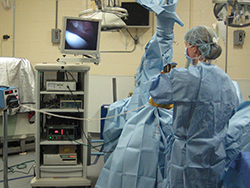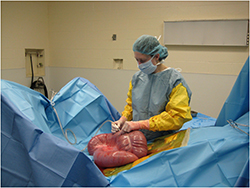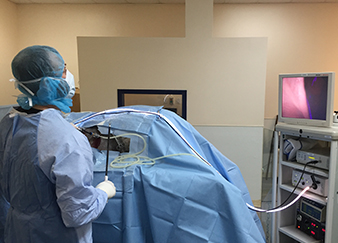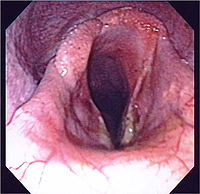Equine Surgical Services
We perform a number of equine surgical services at our facility in Burton, Ohio. All surgery is performed by board certified surgeons. They are aided by our team of registered veterinary technicians and veterinary assistants to provide your horse with the best care available.
Orthopedic Surgery
Arthroscopy & Fracture Repair

Orthopedic surgery is regularly performed at the hospital. The most common orthopedic procedure performed is arthroscopy where two small incisions are made into the joint and using a scope (arthroscope) to view the interior of the joint, bone fragments can be removed. Repair of fractured bones is also performed at the hospital.
We have a full array of orthopedic implants suitable for just about any fracture that the horse may encounter in a dedicated orthopedic surgery suite.
Soft Tissue Surgery
All types of soft tissue surgeries are performed at the Equine Specialty Hospital. Elective surgeries include but are not limited to:
- Respiratory procedures for laryngeal hemiplegia & dorsal displacement of the soft palate
- Wound reconstruction
- Correction of angular & flexural limb deformities in foals
- Reproductive surgery including castration, ovariectomy and removal of genitalia tumors
- Ophthalmic procedures including enucleation, conjunctival flaps, and eyelid reconstruction
Colic Surgery

Colic surgery is performed on an emergency basis 24 hours a day, 365 days a year.
Our board-certified surgeons perform all types of colic surgery on all ages of horses. Large colon displacements and large colon torsions are the most common surgical problems of the large colon. Common small intestinal problems include strangulating lipomas and epiploic foramen entrapments, but many other conditions are also diagnosed and treated. Small intestinal problems often require a resection and anastomosis (removal of severely damaged intestine).
Anesthesia is administered by registered veterinary technicians, and horses are monitored intra-operatively (as are all general anesthesia patients at the hospital) with an electrocardiogram (ECG) and direct arterial blood pressure assessment, and breathing is assisted and supported with a ventilator.
Post-operatively, horses are monitored 24 hours a day. Heart rate, respiratory rate, temperature, and gastrointestinal sounds are carefully documented multiple times daily. Administration of intravenous fluids, antibiotics, anti-inflammatory medications, and medication for pain are administered for several days after surgery. Re-introduction of food and water occurs slowly, and appetite and manure production are closely monitored.
Dystocia/Caesarean Surgery
When a dystocia is present there is very little time to correct the positioning of the foal to ensure foal and mare survival. At the hospital the mare can be anesthetized and the foal manipulated to aid in delivery. If this is unsuccessful, we are able to perform a C-section.
Elective caesareans are less frequent but are available based on the recommendation of your veterinarian.
Laparoscopic Surgery

Laparoscopy is available for select patients. The most common use of laparoscopy is thoracoscopy in evaluating pulmonary abscesses and tumors, and obtaining lung biopsies.
The field of equine laparoscopy has grown rapidly and is now used as a routine approach for procedures such as removal of cryptorchid testicles in colts and removal of abnormal ovaries in mares with conditions such as ovarian tumors. Both procedures tend to yield excellent post-operative results with minimal post-operative pain and a rapid return to athletic function. Laparoscopic techniques substantially improve procedures associated with a high risk for catastrophic complications when done via open approaches. Laparoscopy can also be used to resolve problems that were previously not treatable due to lack of surgical access (eg: closure of small colon mesenteric rents and closure of the internal inguinal ring without castration in breeding stallions).
Typically, laparoscopy involves insertion of a 10 mm laparoscope into the abdomen of the horse to allow viewing of the majority of the organs in the abdomen. How much of a view depends on the surgical approach taken. Laparoscopy can be used both under general anesthesia and in the standing horse. As a result of small incision size and minimal tissue trauma, laparoscopy is associated with decreased duration and severity of post-operative pain and decreased incidence of post-operative incisional complications. The exact location of the incision in the abdomen varies with the purpose of the surgery.
Upper Airway Surgery

Soft palate abnormalities, such as dorsal displacement of the soft palate, are treated with a variety of surgical procedures, the most common being a tie forward. Laryngeal hemiplegia also has a variety of surgical options including a tie back (laryngoplasty), Laryngoplasty with Sacculectomy, or laser Ventriculocordectomy. Epiglottic entrapments are also commonly treated surgically.
Dental and Sinus Surgery
Dental procedures performed at the hospital include mandible or maxilla (jaw) fracture repair and dental extractions. Depending on the tooth to be removed, the presence of any concurrent sinus disease, and the temperament of the horse, the procedure may be performed under general anesthesia or standing with sedation and local anesthesia.
Sinus surgery can also be performed standing, or under general anesthesia depending on the type of abnormality and the horse’s temperament. Common problems that require sinus surgery include tooth root abscesses, sinus tumors, sinus cysts, and severe sinusitis (infection).


